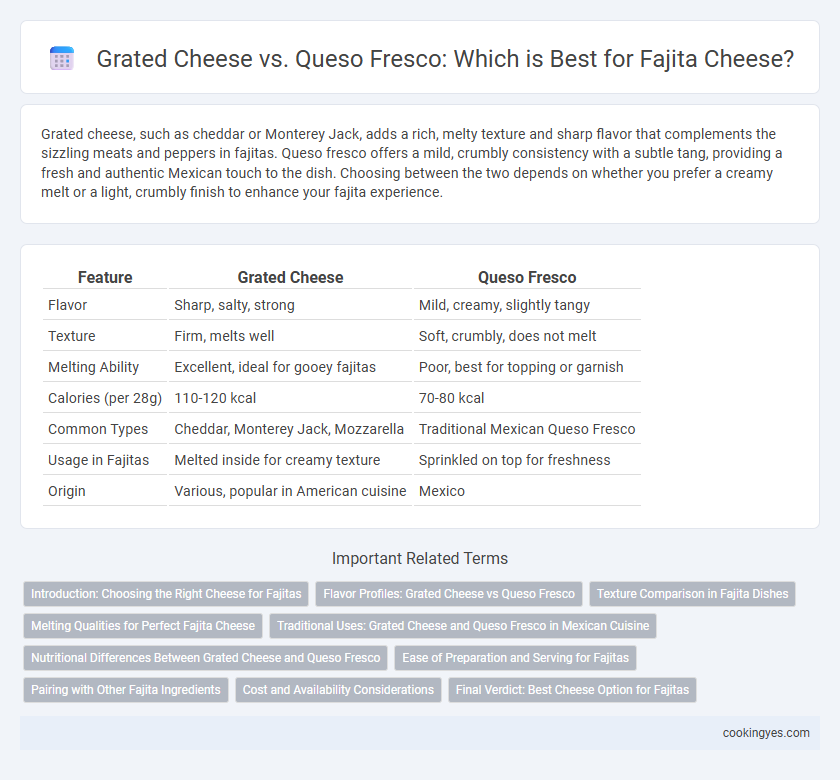Grated cheese, such as cheddar or Monterey Jack, adds a rich, melty texture and sharp flavor that complements the sizzling meats and peppers in fajitas. Queso fresco offers a mild, crumbly consistency with a subtle tang, providing a fresh and authentic Mexican touch to the dish. Choosing between the two depends on whether you prefer a creamy melt or a light, crumbly finish to enhance your fajita experience.
Table of Comparison
| Feature | Grated Cheese | Queso Fresco |
|---|---|---|
| Flavor | Sharp, salty, strong | Mild, creamy, slightly tangy |
| Texture | Firm, melts well | Soft, crumbly, does not melt |
| Melting Ability | Excellent, ideal for gooey fajitas | Poor, best for topping or garnish |
| Calories (per 28g) | 110-120 kcal | 70-80 kcal |
| Common Types | Cheddar, Monterey Jack, Mozzarella | Traditional Mexican Queso Fresco |
| Usage in Fajitas | Melted inside for creamy texture | Sprinkled on top for freshness |
| Origin | Various, popular in American cuisine | Mexico |
Introduction: Choosing the Right Cheese for Fajitas
Grated cheese and queso fresco offer distinct textures and flavors crucial for authentic fajitas. Grated cheese, often a blend of cheddar or Monterey Jack, melts smoothly and provides a creamy, rich taste that enhances the sizzling fajita filling. Queso fresco, a crumbly Mexican cheese, delivers a mild, slightly tangy flavor and a refreshing contrast that balances spicy fajita seasonings perfectly.
Flavor Profiles: Grated Cheese vs Queso Fresco
Grated cheese, such as cheddar or Monterey Jack, offers a sharp, creamy flavor that melts smoothly over fajitas, enhancing richness and adding a gooey texture. Queso fresco provides a mild, slightly tangy taste with a crumbly texture that balances spicy fajita fillings without overpowering them. Choosing between grated cheese and queso fresco depends on desired flavor intensity and melting quality in fajita preparation.
Texture Comparison in Fajita Dishes
Grated cheese offers a smooth, melting texture that provides a creamy, cohesive layer atop fajitas, enhancing overall mouthfeel. Queso fresco, with its crumbly and slightly grainy consistency, adds a fresh, tangy contrast that complements the savory filling without overpowering it. Choosing between grated cheese and queso fresco depends on whether a rich, melted texture or a light, crumbly freshness is desired for the fajita experience.
Melting Qualities for Perfect Fajita Cheese
Grated cheese like Monterey Jack or cheddar melts smoothly and evenly, creating a creamy texture that enhances the fajita's juicy fillings and ensures a cohesive bite. Queso fresco, while offering a mild, slightly tangy flavor, has a crumbly texture that does not melt well, making it better suited for topping rather than a melted cheese layer. For the perfect fajita experience, choosing a grated cheese with excellent melting qualities is essential to achieve that gooey, rich consistency.
Traditional Uses: Grated Cheese and Queso Fresco in Mexican Cuisine
Grated cheese, such as Oaxaca or Chihuahua, melts smoothly and adds a creamy texture to fajitas, enhancing their rich, savory flavor with a traditional Mexican touch. Queso fresco, a crumbly, mild cheese, provides a fresh contrast by adding a light, tangy element that balances spicy fajita fillings without overpowering them. Both cheeses hold distinct places in Mexican cuisine, with grated cheese used for melting and binding, while queso fresco is favored for its crumbly texture and simplicity in authentic fajita preparations.
Nutritional Differences Between Grated Cheese and Queso Fresco
Grated cheese used in fajitas, often cheddar or Monterey Jack, contains higher fat and calorie levels along with increased protein content compared to queso fresco, which is lower in fat and sodium but offers a milder flavor. Queso fresco provides essential nutrients such as calcium and vitamin A with fewer calories, making it a lighter option ideal for those monitoring fat intake. Choosing between grated cheese and queso fresco for fajitas depends on balancing richer taste and creamy texture against lower fat content and a fresher, crumbly consistency.
Ease of Preparation and Serving for Fajitas
Grated cheese, such as cheddar or Monterey Jack, melts quickly and evenly, making it ideal for fajitas due to its ease of preparation and seamless incorporation into hot fillings. Queso fresco, a crumbly, mild Mexican cheese, requires no melting and offers a fresh, tangy contrast that can be easily sprinkled on top after cooking, simplifying serving and enhancing texture. The choice depends on whether a creamy melt or a fresh finish is preferred, with grated cheese offering smoother integration and queso fresco providing quick, no-cook convenience.
Pairing with Other Fajita Ingredients
Grated cheese, such as cheddar or Monterey Jack, melts smoothly over fajitas, complementing the savory grilled meats and sauteed peppers while adding a rich, creamy texture. Queso fresco offers a crumbly, mildly tangy contrast that pairs well with fresh ingredients like diced tomatoes, onions, and cilantro, enhancing the fajita's bright, fresh flavors without overpowering. Both cheeses balance the smoky, spiced profile of fajitas but provide distinct textural and flavor experiences that cater to different preferences.
Cost and Availability Considerations
Grated cheese, such as cheddar or Monterey Jack, is generally more cost-effective and widely available in most grocery stores, making it a convenient choice for fajitas. Queso fresco, while offering a distinct, mild flavor and crumbly texture ideal for authentic Mexican fajitas, can be more expensive and less accessible outside of specialty or Latin markets. Choosing between the two depends on budget constraints and local availability, with grated cheese often favored for its affordability and ease of purchase.
Final Verdict: Best Cheese Option for Fajitas
Grated cheddar offers a sharp, melty texture that complements fajitas with rich, creamy flavor and excellent meltability, enhancing the overall mouthfeel. Queso fresco provides a mild, crumbly option that adds a fresh, slightly tangy taste but lacks melting properties, preserving the traditional Mexican flavor profile. For the best cheese option in fajitas, grated cheddar is ideal for a gooey, savory experience, while queso fresco suits those seeking authenticity and a lighter texture.
Grated cheese vs Queso fresco for Fajita cheese Infographic

 cookingyes.com
cookingyes.com